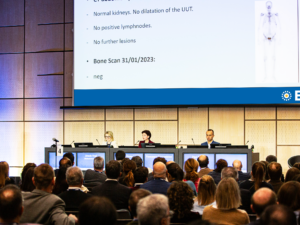Today, Plenary Session 3 of the EAU Section of Urological Imaging (ESUI) meeting examined the latest evidence in three imaging trials and their clinical implications. Assoc. Prof. Veeru Kasivisvanathan (GB) and Assoc. Prof. Giovanni Lughezzani (IT) spearheaded the session.
ZIRCON
During his presentation, “ZIRCON – Girentuximab-PET/CT in RCC phase III trial”, Prof. Peter Mulders (NL) stated that the ZIRCON (Zirconium in Renal Cancer Oncology, NCT03849118) Phase III pivotal study with 89Zr-DFO-girentuximab has met its primary endpoint. The study exceeded sensitivity and specificity targets, and met its key secondary endpoint of sensitivity and specificity in small masses (cT1a ≤4cm).
Furthermore, the study corroborated a favourable safety and tolerability profile of 89Zr-DFO-girentuximab. Results suggested that 89Zr-DFO-girentuximab improves the identification of primary clear cell renal cell carcinoma (ccRCC) compared to cross-sectional imaging.
Prof. Mulders underscored that 89Zr-DFO-girentuximab has the potential to improve management by aiding risk stratification, selecting appropriate patients for treatment, or suggesting where further imaging/biopsy could be indicated. In addition, 89Zr-DFO-girentuximab exhibits potential such as in the improvement of staging in ccRCC, and more.
PRIME
In his presentation, “Comparison of biparametric and multiparametric magnetic resonance imaging for prostate cancer detection: An update on the PRIME Study (NCT04571840)”, Prof. Kasivisvanathan stated that previous studies comparing biparametric (bpMRI) and multiparametric MRI (mpMRI) had limitations. These were the inclusion of small, single-centre, or retrospective studies; lack of strict blinding of radiologists when reporting both bpMRI and mpMRI; and no MRI quality control, to name a few. Hence, the inception of the PRIME study.
With broad participation across five continents, the PRIME study is a 500-patient prospective, within-patient, multicentre, level 1-evidence study. It investigates whether bpMRI is non-inferior to mpMRI in the detection of clinically significant prostate cancer (csPCa).
Since MRI quality control was central to designing PRIME, the aim was to evaluate the quality of all MRI scanners taking part in PRIME using the PI-QUAL score, and to make suggestions on how to improve MR protocols to ensure all scanners taking part were of optimal diagnostic quality, PI-QUAL 5.
Prof. Kasivisvanathan stated that the study aims to provide high-quality evidence on whether bpMRI can become the new standard of care for PCa diagnosis. The core objective is to streamline the PCa diagnosis pathway for men to be able to access MRI when needed.
The results of the PRIME study will be published in six months.
PRECISE
The key takeaways of the presentation “PRECISE trial: MRI features predicting active surveillance failure” by Dr. Armando Stabile (IT) were that the PRECISE score alone is not enough to decide on whether to perform a follow-up biopsy under active surveillance. He added, “For patients with excellent characteristics at the baseline with a serial MRI that is reassuring, this subset of patients need not be considered for a follow-up biopsy because they have a very low risk of long-term reclassification.”
In addition, the PRECISE score should be used in combination with biomarkers (e.g. PSAD [prostate specific antigen density], etc.) to decrease the proportion of useless biopsies.
According to Dr. Stabile, the baseline PI-RADS score is one of the strongest predictors. As an example, he advised that if a patient has a PIRADS 4-5 score that improves over time to still monitor that patient as there is still a small risk for him to progress to the mid-term [classification].”
Dr. Stabile emphasised that the PRECISE score holds its predictive value over time.
Review the take-home messages of the session and watch the complete presentations via the EMUC23 Resource Centre.





